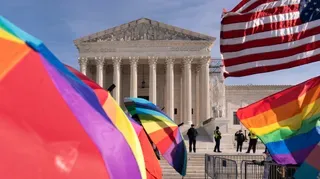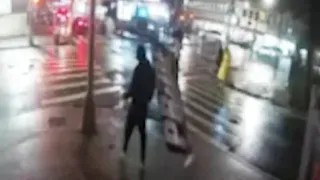September 18, 2013
LGBT Teen Homelessness in South Florida, Part 2
Kilian Melloy READ TIME: 7 MIN.
A sunburned kid seeking cool air for a few minutes. A teen using the computer to apply for jobs.
While the LGBT Visitor Center in Miami Beach is primarily the center of the city's tourism, its rainbow flags have also become a signal to gay teens living on the street that it's a safe haven.
Karen Brown, the executive director of the center, said she has about a dozen homeless teens, both straight and LGBT, come into the center on a regular basis to apply for jobs at the computer center, charge their cell phones, cool off, or get snacks. When she first started, she naively gave them some cash to take the bus. She quickly learned the kids weren't using it for that.
"I can't be mad at them for trying to survive," she said. "You still have to be compassionate."
Although numbers vary from study to study, it's estimated that about 40 percent of homeless youth identify as LGBT - disproportionate from their representation in the general youth population. About 110,000 LGBT youth become homeless each year in the United States, according to the National Alliance to End Homelessness, and once they are on the street, they are more likely to experience physical and sexual assault than their straight peers. They are also more than 30 percent more likely to attempt suicide once they're homeless.
For Jamesly Louis, 22, it was a feeling of completely hopelessness that led him to become homeless at 16. Being gay was a part of him since he could remember, and his highly religious Haitian family would not acknowledge it. He was bullied at school, teachers ignored him, and he felt like he was the only person in the world who was homosexual.
"All I wanted was someone, some type of connection to make me feel like I was not alone. I really felt that deep down, well maybe I don't belong here; if I'm the only one that's like that then why am I here?"
After he confided in his high school's TRUST counselor that he was "going to do something stupid" when he got home, she immediately called Pridelines Youth Services, who referred him to Covenant House in Fort Lauderdale. After he went home to pack his things, Louis took a two-hour bus ride from Miami to the shelter in the middle of the night.
"I was a bit scared. When I got there the paperwork took a lot of time to complete," Louis said. "When I woke up the next morning, my mind was at peace."
Louis got to work right away to start a new life. He found at job as a seasonal worker at J. Crew at the Aventura Mall - another two-hour bus ride - and signed up for program where staff would hold onto his money to help him save up for an apartment. Since he was only on a tourist visa - his mother brought him and his siblings to Miami from Haiti to marry a man who never filed for their permanent status - but an immigration lawyer helped him turn it into a special immigrant visa. On the anniversary of that day, he brings her a flower to say thank you.
For the two months living at the shelter, Louis's biggest problem was dealing with homophobic kids. Some roommates would egg him on to tell them he was gay, and some other gay kids were bullied.
"I [saw] a lot of fights because gay kids just look at another guy, and then he doesn't like the way he looked at him, and a fight," Louis remembers. "I kept to myself and I keep myself focused. I was like, I am here to seek some help and I'm not here for the rest of it. The minute I get enough money, I'm moving out. I had a plan and I did not want to be disoriented. I wanted to keep focus."
While there isn't much that staff can do when it comes to homophobic clients at a shelter, LGBT advocates are working with shelters to train staff in how to handle LGBT people's needs. Mandi Hawke, the director of youth services at SunServe in Fort Lauderdale, has done training at Covenant House, the Homeless Assistance Center, and other agencies. This includes the proper vocabulary and how to approach someone about their sexuality or gender identity.
"There's always new youth coming in that may be homophobic and we can't really do anything about that, but we definitely do everything we can to train the foster care system, the homeless care system, all therapists in the community," Hawke said.
An important lesson for staff at homeless shelters, or those working with LGBT youth, is to learn how to talk to someone about their sexuality and gender identity. In Hawke's experience, many well-intentioned people avoid using pronouns when they encounter someone who is ambiguous in their gender for fear of offending, when in actuality it's a sign of respect and alleviates anxiety to simply ask.
The biggest problem is youths admitting their sexuality to advocates, not because they're ashamed, but they've been programmed to believe that they won't receive help if they give up that information. Posted on the wall behind her desk is a poster she encourages all advocates to have: Equality is my Priority. When a youth is sitting across from her, she knows he or she is being informed that they're in a safe environment.
"We really live in a heterosexist world, right? And so we just assume everyone is straight," said Carla Silva, the executive director of The Alliance for GLBTQ Youth.
The Alliance is one of seven LGBT and homeless agencies that recently came together to form the LGBTQ Youth Homelessness Initiative with help from Florida Rep. David Richardson, who secured state funding for safe housing. They are working on the local level to combat homelessness among LGBT youth by educating agencies, increasing the number of foster families willing to take in LGBT children, and ensure a constant stream of funding.
Twice a year, the Homeless Trust leads a homeless count, with people fanning across the county in homeless "hot spots" to get an accurate number of the population. When surveys are done, the homeless are asked for their gender identity, with the option to refuse.
In the Unaccompanied Youth Count/Survey pilot in August, one that included more than a dozen agencies - the question of sexual orientation was added since so many homeless youth identify as LGBT - again, a question that can be refused.
"The question regarding sexual orientation is primarily for the youth count, as nationally it is estimated that 40 percent of the unaccompanied homeless youth say they lost their housing either directly/indirectly due to their sexual orientation," Ron Book, the chairman of the Homeless Trust, wrote in an email. "This information is useful for local LGBTQ youth-serving organizations to address homeless prevention/interventions."
About 100 volunteers from more than a dozen local organizations took to the streets on foot or bicycle, scoping out groups of youths. If they are in fact homeless, they encourage them to take a survey to help the county provide data to the Department of Housing and Development. Serving as a "hot spot," the visitor center is the command center for volunteers to collect plastic bags filled with donated toiletries, coupons and snacks.
"Most of them don't consider themselves to be homeless," said the Rev. Grey Maggiano of Trinity Cathedral in Miami. "For them, homeless is you're old, have a drug problem, and you sleep on the street."
Many might not be sleeping under a bridge at night, but they sure don't know whose couch they'll be crashing on. The few teens who would talk to Maggiano - who had better luck in the downtown Miami area - told him their moms chose love over them, parents had drug problems, stepfathers abused them, or ran away from foster care.
Maggiano said no one brought up their sexuality and he doubts any would reveal another layer of vulnerability to a stranger.
On all levels of governance, the information is fairly new. It's been long thought that asking someone's sexuality or gender identity in surveys is invasive and could lead to discrimination - when South Florida Gay News reached out to the Department of Health and Human Services, a spokesman said they did not have any data of gay homeless youth.
"We can't track the data if you don't ask and we can't make sure that this population is cared for. It honestly just keeps them in the closet and that's also very frustrating," Hawke said.
Luckily for Louis, he had no qualms about his sexuality and was perhaps more headstrong than other teens who were in his situation. He managed to continue going to school while living at Covenant House for two months, shuttling back and forth between Fort Lauderdale and Aventura for work. He saved up enough money to crash on someone's couch and eventually went to Miami-Dade College. Today, he is a student at the New World School of the Arts' theater program and lives in an apartment with other college students.
To give back, he is now on the board of Pridelines as a public speaker and working with marketing efforts.
"When I was young, if someone like myself were to tell me their story, maybe I would have a better chance at a lot of things. A lot of kids in this world, like those who unfortunately [are taking their lives] not because they're gay, but because they feel so alone and they have nowhere to go."
When asked what could be done to help gay teens, Louis isn't optimistic. For him, all the training in the world won't change someone's homophobic attitudes. However, he hopes that one day school will be a safe place for everyone, and that teachers and counselors regardless of their beliefs will be willing to help every student.
Hawke said, "This is an issue that's definitely still here in South Florida, and it's our kids, and it's our community. We need to do something about it."
Kilian Melloy serves as EDGE Media Network's Associate Arts Editor and Staff Contributor. His professional memberships include the National Lesbian & Gay Journalists Association, the Boston Online Film Critics Association, The Gay and Lesbian Entertainment Critics Association, and the Boston Theater Critics Association's Elliot Norton Awards Committee.





